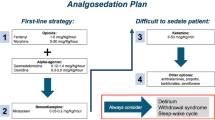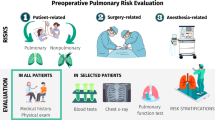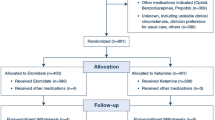Abstract
Morbidly obese patients due to high incidence of obstructive sleep apnea (OSA) are predisposed to opioid induced airway obstruction and thus frontline high ceiling analgesics (opioids) have concerns based on safety in their liberal use. Although surgical techniques over the last two decades have seen a paradigm shift from open to laparoscopic procedures for morbidly obese patients; optimally titrated yet safe analgesic management still remains a challenge. The present review sums up the analgesic options available for management of morbidly obese patients undergoing surgery. We highlight the utility of multimodal approach for analgesia with combinations of agents to decrease opioids requirements. Pre-emptive analgesia may be additionally used to improve the efficacy of postoperative pain relief while allowing further reductions in opioid requirements.

Similar content being viewed by others
References
Lopez PP, Stefan B, Schulman CI, et al. Prevalence of sleep apnea in morbidly obese patients who presented for weight loss surgery evaluation: more evidence for routine screening for obstructive sleep apnea before weight loss surgery. Am Surg. 2008;74(9):834–8.
Wadhwa A, Singh PM, Sinha AC. Airway management in patients with morbid obesity. Int Anesthesiol Clin. 2013;51(3):26–40.
Taylor S, Kirton OC, Staff I, et al. Postoperative day one: a high risk period for respiratory events. Am J Surg. 2005;190(5):752–6.
Doufas AG, Tian L, Padrez KA, et al. Experimental pain and opioid analgesia in volunteers at high risk for obstructive sleep apnea. PloS One. 2013;8(1):e54807.
Yeomans MR, Gray RW. Selective effects of naltrexone on food pleasantness and intake. Physiol Behav. 1996;60(2):439–46.
Yeomans MR, Gray RW. Effects of naltrexone on food intake and changes in subjective appetite during eating: evidence for opioid involvement in the appetizer effect. Physiol Behav. 1997;62(1):15–21.
Khawaja XZ, Chattopadhyay AK, Green IC. Increased beta-endorphin and dynorphin concentrations in discrete hypothalamic regions of genetically obese (ob/ob) mice. Brain Res. 1991;555(1):164–8.
Rand CSW, Kuldau JM, Yost RL. Obesity and post-operative pain. J Psychosom Res. 1985;29(1):43–8.
Aubrun F, Mazoit J-X, Riou B. Postoperative intravenous morphine titration. Br J Anaesth. 2012;108(2):193–201.
Gross JB, Bachenberg KL, Benumof JL, et al. Practice guidelines for the perioperative management of patients with obstructive sleep apnea: a report by the American Society of Anesthesiologists Task Force on Perioperative Management of patients with obstructive sleep apnea. Anesthesiology. 2006;104(5):1081–93. quiz 1117–1118.
Schumann R, Jones SB, Cooper B, et al. Update on best practice recommendations for anesthetic perioperative care and pain management in weight loss surgery, 2004–2007. Obes Silver Spring Md. 2009;17(5):889–94.
Feld JM, Laurito CE, Beckerman M, et al. Non-opioid analgesia improves pain relief and decreases sedation after gastric bypass surgery. Can J Anaesth J Can Anesth. 2003;50(4):336–41.
Govindarajan R, Ghosh B, Sathyamoorthy MK, et al. Efficacy of ketorolac in lieu of narcotics in the operative management of laparoscopic surgery for morbid obesity. Surg Obes Relat Dis Off J Am Soc Bariatr Surg. 2005;1(6):530–5. discussion 535–536.
Ding Y, White PF. Comparative effects of ketorolac, dezocine, and fentanyl as adjuvants during outpatient anesthesia. Anesth Analg. 1992;75(4):566–71.
Sasse KC, Ganser J, Kozar M, Watson RW, McGinley L, Lim D, et al. Seven cases of gastric perforation in Roux-en-Y gastric bypass patients: what lessons can we learn? Obes Surg. 2008;18(5):530–4.
Wong I, St John-Green C, Walker SM. Opioid-sparing effects of perioperative paracetamol and nonsteroidal anti-inflammatory drugs (NSAIDs) in children. Paediatr Anaesth. 2013;23(6):475–95.
Remy C, Marret E, Bonnet F. Effects of acetaminophen on morphine side-effects and consumption after major surgery: meta-analysis of randomized controlled trials. Br J Anaesth. 2005;94(4):505–13.
Baerdemaeker LED, Mortier EP, Struys MM. Pharmacokinetics in obese patients. Contin Educ Anaesth Crit Care Pain. 2004;4(5):152–5.
Kaur M, Singh P. Current role of dexmedetomidine in clinical anesthesia and intensive care. Anesth Essays Res. 2011;5(2):128.
Tufanogullari B, White PF, Peixoto MP, et al. Dexmedetomidine infusion during laparoscopic bariatric surgery: the effect on recovery outcome variables. Anesth Analg. 2008;106(6):1741–8.
Blaudszun G, Lysakowski C, Elia N, et al. Effect of perioperative systemic α2 agonists on postoperative morphine consumption and pain intensity: systematic review and meta-analysis of randomized controlled trials. Anesthesiology. 2012;116(6):1312–22.
Yildiz M, Tavlan A, Tuncer S, et al. Effect of dexmedetomidine on haemodynamic responses to laryngoscopy and intubation : perioperative haemodynamics and anaesthetic requirements. Drugs RD. 2006;7(1):43–52.
Laulin J-P, Maurette P, Corcuff J-B, et al. The role of ketamine in preventing fentanyl-induced hyperalgesia and subsequent acute morphine tolerance. Anesth Analg. 2002;94(5):1263–9. table of contents.
Hirota K, Zsigmond EK, Matsuki A, et al. Topical ketamine inhibits albumin extravasation in chemical peritonitis in rats. Acta Anaesthesiol Scand. 1995;39(2):174–8.
Zakine J, Samarcq D, Lorne E, et al. Postoperative ketamine administration decreases morphine consumption in major abdominal surgery: a prospective, randomized, double-blind, controlled study. Anesth Analg. 2008;106(6):1856–61.
Schmid RL, Sandler AN, Katz J. Use and efficacy of low-dose ketamine in the management of acute postoperative pain: a review of current techniques and outcomes. Pain. 1999;82(2):111–25.
Liu HT, Hollmann MW, Liu WH, et al. Modulation of NMDA receptor function by ketamine and magnesium: Part I. Anesth Analg. 2001;92(5):1173–81.
Ryu J-H, Kang M-H, Park K-S, et al. Effects of magnesium sulphate on intraoperative anaesthetic requirements and postoperative analgesia in gynaecology patients receiving total intravenous anaesthesia. Br J Anaesth. 2008;100(3):397–403.
Cabrera Schulmeyer MC, de la Maza J, Ovalle C, et al. Analgesic effects of a single preoperative dose of pregabalin after laparoscopic sleeve gastrectomy. Obes Surg. 2010;20(12):1678–81.
Cotter JT, Nielsen KC, Guller U, et al. Increased body mass index and ASA physical status IV are risk factors for block failure in ambulatory surgery — an analysis of 9,342 blocks. Can J Anaesth J Can Anesth. 2004;51(8):810–6.
Davies KE, Houghton K, Montgomery JE. Obesity and day-case surgery. Anaesthesia. 2001;56(11):1112–5.
Kehlet H, Holte K. Effect of postoperative analgesia on surgical outcome. Br J Anaesth. 2001;87(1):62–72.
Rodgers A, Walker N, Schug S, et al. Reduction of postoperative mortality and morbidity with epidural or spinal anaesthesia: results from overview of randomised trials. BMJ. 2000;321(7275):1493.
Franco CD, Gloss FJ, Voronov G, et al. Supraclavicular block in the obese population: an analysis of 2020 blocks. Anesth Analg. 2006;102(4):1252–4.
Kumar N. Nutritional neuropathies. Neurol Clin. 2007;25(1):209–55.
Thaisetthawatkul P. Neuromuscular complications of bariatric surgery. Phys Med Rehabil Clin N Am. 2008;19(1):111–24. vii.
Brodsky JB, Mariano ER. Regional anaesthesia in the obese patient: lost landmarks and evolving ultrasound guidance. Best Pract Res Clin Anaesthesiol. 2011;25(1):61–72.
Sites BD, Brull R, Chan VWS, et al. Artifacts and pitfall errors associated with ultrasound-guided regional anesthesia: Part I. Understanding the basic principles of ultrasound physics and machine operations. Reg Anesth Pain Med. 2007;32(5):412–8.
Al-Nasser B. Review of interscalene block for postoperative analgesia after shoulder surgery in obese patients. Acta Anaesthesiol Taiwan Off J Taiwan Soc Anesthesiol. 2012;50(1):29–34.
Hayashi H, Ueyama H. Experience of ultrasound-guided popliteal sciatic nerve block and femoral nerve perineural catheter placement in a morbidly obese patient undergoing total knee arthroplasty. Masui. 2010;59(10):1260–2.
Abdallah FW, Chan VW, Brull R. Transversus abdominis plane block: a systematic review. Reg Anesth Pain Med. 2012;37(2):193–209.
Niraj G, Kelkar A, Jeyapalan I, et al. Comparison of analgesic efficacy of subcostal transversus abdominis plane blocks with epidural analgesia following upper abdominal surgery. Anaesthesia. 2011;66(6):465–71.
Naja ZM, Naccache N, Ziade F, et al. Multilevel nerve stimulator-guided paravertebral block as a sole anesthetic technique for breast cancer surgery in morbidly obese patients. J Anesth. 2011;25(5):760–4.
Cottam DR, Fisher B, Atkinson J, et al. A randomized trial of bupivicaine pain pumps to eliminate the need for patient controlled analgesia pumps in primary laparoscopic Roux-en-Y gastric bypass. Obes Surg. 2007;17(5):595–600.
Sherwinter DA, Ghaznavi AM, Spinner D, et al. Continuous infusion of intraperitoneal bupivacaine after laparoscopic surgery: a randomized controlled trial. Obes Surg. 2008;18(12):1581–6.
Hernández-Palazón J, Tortosa JA, Nuño de la Rosa V, et al. Intraperitoneal application of bupivacaine plus morphine for pain relief after laparoscopic cholecystectomy. Eur J Anaesthesiol. 2003;20(11):891–6.
Buckley FP, Robinson NB, Simonowitz DA, et al. Anaesthesia in the morbidly obese. A comparison of anaesthetic and analgesic regimens for upper abdominal surgery. Anaesthesia. 1983;38(9):840–51.
Smetana GW. Postoperative pulmonary complications: an update on risk assessment and reduction. Cleve Clin J Med. 2009;76(Suppl_4):S60–5.
Moraca RJ, Sheldon DG, Thirlby RC. The role of epidural anesthesia and analgesia in surgical practice. Ann Surg. 2003;238(5):663–73.
Brodsky JB, Lemmens HJM. Update on local and regional anesthesia in obesity. Acta Anaesthesiol Belg. 2009;60(3):181–3.
Lang SA, Arraf J. Analgesia in bariatric patients following upper abdominal surgery. Can J Anaesth J Can Anesth. 2004;51(3):276. author reply 276.
Ellinas EH, Eastwood DC, Patel SN, et al. The effect of obesity on neuraxial technique difficulty in pregnant patients: a prospective, observational study. Anesth Analg. 2009;109(4):1225–31.
von Ungern-Sternberg BS, Regli A, Reber A, et al. Effect of obesity and thoracic epidural analgesia on perioperative spirometry. Br J Anaesth. 2005;94(1):121–7.
Schumann R, Shikora S, Weiss JM, et al. A comparison of multimodal perioperative analgesia to epidural pain management after gastric bypass surgery. Anesth Analg. 2003;96(2):469–74. table of contents.
Gelman S, Laws HL, Potzick J, et al. Thoracic epidural vs balanced anesthesia in morbid obesity: an intraoperative and postoperative hemodynamic study. Anesth Analg. 1980;59(12):902–8.
Michaloudis D, Fraidakis O, Petrou A, et al. Continuous spinal anesthesia/analgesia for perioperative management of morbidly obese patients undergoing laparotomy for gastroplastic surgery. Obes Surg. 2000;10(3):220–9.
Singh S, Wirth KM, Phelps AL, et al. Epidural catheter placement in morbidly obese parturients with the use of an epidural depth equation prior to ultrasound visualization. Sci World J [Internet]. 2013 Jul 25 [cited 2013 Aug 7];2013. Available from: http://www.hindawi.com/journals/tswj/2013/695209/abs/
Rawal N, Sjöstrand U, Christoffersson E, et al. Comparison of intramuscular and epidural morphine for postoperative analgesia in the grossly obese: influence on postoperative ambulation and pulmonary function. Anesth Analg. 1984;63(6):583–92.
Hindle A. Intrathecal opioids in the management of acute postoperative pain. Contin Educ Anaesth Crit Care Pain. 2008;8(3):81–5.
Singh PM, Wadhwa A. Multimodal analgesia in patients with morbid obesity. Bariatr Times. 2013;10(11):24–9.
Sprigge JS, East DS, Fox GS, et al. Meperidine infusion for postoperative analgesia in grossly obese patients. Can Anaesth Soc J. 1982;29(2):142–7.
Levin A, Klein SL, Brolin RE, et al. Patient-controlled analgesia for morbidly obese patients: an effective modality if used correctly. Anesthesiology. 1992;76(5):857–8.
Van Kralingen S, van de Garde EMW, van Dongen EPA, et al. Maintenance of anesthesia in morbidly obese patients using propofol with continuous BIS-monitoring: a comparison of propofol-remifentanil and propofol-epidural anesthesia. Acta Anaesthesiol Belg. 2011;62(2):73–82.
Choi YK, Brolin RE, Wagner BK, et al. Efficacy and safety of patient-controlled analgesia for morbidly obese patients following gastric bypass surgery. Obes Surg. 2000;10(2):154–9.
Goudra BG, Singh PM, Sinha AC. Anesthesia for ERCP: impact of anesthesiologist’s experience on outcome and cost. Anesthesiol Res Pract [Internet]. 2013 May 28 [cited 2013 Jun 7];2013. Available from: http://www.hindawi.com/journals/arp/2013/570518/abs/.
Goudra BG, Singh PM, Sinha A. Outpatient endoscopic retrograde cholangiopancreatography: safety and efficacy of anesthetic management with a natural airway in 653 consecutive procedures. Saudi J Anaesth. 7(3):259–65.
Nguyen NT, Furdui G, Fleming NW, et al. Effect of heated and humidified carbon dioxide gas on core temperature and postoperative pain: a randomized trial. Surg Endosc. 2002;16(7):1050–4.
Farley DR, Greenlee SM, Larson DR, et al. Double-blind, prospective, randomized study of warmed, humidified carbon dioxide insufflation vs standard carbon dioxide for patients undergoing laparoscopic cholecystectomy. Arch Surg Chic Ill 1960. 2004;139(7):739–43. discussion 743–744.
Savel RH, Balasubramanya S, Lasheen S, et al. Beneficial effects of humidified, warmed carbon dioxide insufflation during laparoscopic bariatric surgery: a randomized clinical trial. Obes Surg. 2005;15(1):64–9.
De Oliveira GS, Fitzgerald Jr P, Streicher LF, et al. Systemic lidocaine to improve postoperative quality of recovery after ambulatory laparoscopic surgery. Anesth Analg. 2012;115(2):262–7.
Conflicts of Interests
None of the other authors have any other disclosures to report in relation to the content of this manuscript.
Author information
Authors and Affiliations
Corresponding author
Rights and permissions
About this article
Cite this article
Alvarez, A., Singh, P.M. & Sinha, A.C. Postoperative Analgesia in Morbid Obesity. OBES SURG 24, 652–659 (2014). https://doi.org/10.1007/s11695-014-1185-2
Published:
Issue Date:
DOI: https://doi.org/10.1007/s11695-014-1185-2




